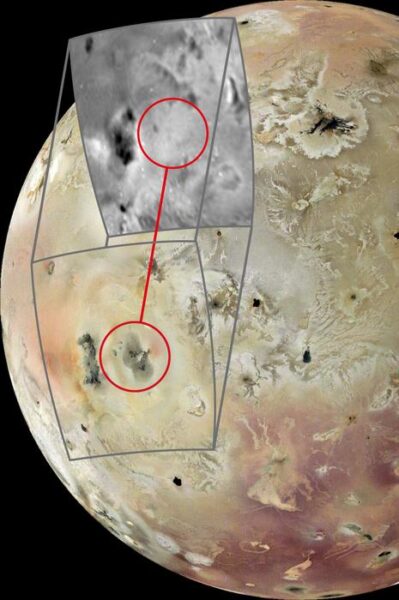Summary: NASA’s Juno mission has captured images revealing a new volcano on Jupiter’s moon Io, marking the first detailed observations of the moon in over two decades and providing fresh insights into its intense volcanic activity.
Estimated reading time: 5 minutes
The JunoCam instrument aboard NASA’s Juno spacecraft has captured startling new images of Jupiter’s moon Io, unveiling a previously unseen volcano on its surface. This discovery, presented at the Europlanet Science Congress in Berlin, marks a significant development in our understanding of the most geologically active body in our solar system.
Io, the innermost of Jupiter’s four largest moons, has long been known for its extreme volcanic activity. However, the recent images provide the first close-up view of the moon in more than 25 years, offering scientists a rare opportunity to observe changes in its dynamic landscape.
A New Volcanic Giant Emerges
The newly discovered volcano is located just south of Io’s equator and covers an area of approximately 180 kilometers by 180 kilometers. What makes this discovery particularly intriguing is that this volcanic feature was not present in images taken by NASA’s Galileo mission in 1997, which showed only a featureless surface in this region.
Michael Ravine, Advanced Projects Manager at Malin Space Science Systems, Inc., which operates JunoCam, expressed surprise at the finding: “Our recent JunoCam images show many changes on Io, including this large, complicated volcanic feature that appears to have formed from nothing since 1997.”
The volcano exhibits several distinctive features:
- A diffuse red stain on its eastern side, likely caused by sulphur vented into space and fallen back onto Io’s surface.
- Two dark streams of lava on the western side, each extending about 100 kilometers.
- Two overlapping grey circular deposits at the farthest point of the lava flows, where heat has vaporized frozen surface material.
Shedding New Light on Io’s Volcanic Activity
The JunoCam captured these images during three recent flybys of Io in 2023 and 2024, taking about 20 close-up color images. These observations have revealed not only the new volcano but also nine plumes associated with active volcanic features and other surface changes such as new lava flows and deposits.
The best image of the new volcano was taken on February 3, 2024, from a distance of 2,530 kilometers, with a scale of 1.7 kilometers per pixel. Remarkably, these images were captured on Io’s nightside, with Jupiter providing the only illumination.
Why It Matters
This discovery is significant for several reasons:
- It provides new insights into the rapid geological changes occurring on Io, helping scientists better understand the moon’s volcanic processes.
- The findings could contribute to our knowledge of planetary formation and evolution, particularly in relation to tidal heating effects in moons orbiting gas giants.
- Studying Io’s extreme volcanism may offer clues about early Earth and other volcanic worlds in our solar system and beyond.
Citizen Science in Action
One of the most exciting aspects of this discovery is the role of public participation in the research. Scott Bolton, the Principal Investigator of NASA’s Juno mission at Southwest Research Institute, highlighted this unique aspect: “JunoCam images are created by people from all walks of life, providing a way for anyone to join our science team and share in the excitement of space exploration.”
This approach not only engages the public in scientific discovery but also allows for a diverse range of perspectives in analyzing the data, potentially leading to additional insights that might be missed by traditional research methods.
Looking Ahead: Future Exploration of Io
While these new images provide valuable information about Io’s current state, they also raise new questions about the moon’s volcanic processes and how they have changed over time. Future missions and observations will be crucial in further unraveling the mysteries of this fascinating Jovian moon.
As we continue to explore our solar system, discoveries like this new volcano on Io remind us of the dynamic and ever-changing nature of the worlds beyond our own, inspiring both scientists and the public alike to keep reaching for the stars.
Quiz:
- In what year were the previous close-up images of Io taken before this recent discovery?
- How large is the area covered by the newly discovered volcano on Io?
- What instrument aboard NASA’s Juno spacecraft captured these new images of Io?
Answer Key:
- The previous close-up images of Io were taken in 1997 by NASA’s Galileo mission.
- The new volcano covers an area of approximately 180 kilometers by 180 kilometers.
- The images were captured by the JunoCam instrument aboard NASA’s Juno spacecraft.
If our reporting has informed or inspired you, please consider making a donation. Every contribution, no matter the size, empowers us to continue delivering accurate, engaging, and trustworthy science and medical news. Independent journalism requires time, effort, and resources—your support ensures we can keep uncovering the stories that matter most to you.
Join us in making knowledge accessible and impactful. Thank you for standing with us!

